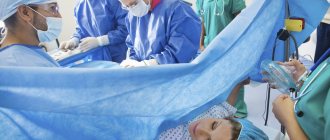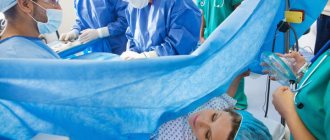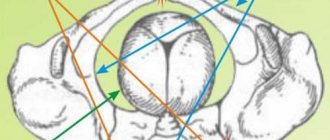After performing a large-scale surgical procedure, suture elements are usually applied. The uterine organ is no exception. In practice, many methods of surgical intervention are used, as a result of which the integrity of the uterine body can be disrupted. The scar on the uterine organ is presented in the form of a tissue compaction formed as a result of mechanical damage (incision). Experts divide postoperative scars into several categories depending on the healing process of the tissue walls. As practice shows, along with the normal regeneration process, the uterine scar can cause some complications. For example, an incompetent scar on the uterus can cause rupture of the uterine body during pregnancy (at a later date, almost on the eve of delivery).
Causes
Suture failure poses a serious threat to both the woman and the fetus. Adhesions on the organ cause the placenta to be incorrectly positioned. In case of abnormal placenta accreta, when the embryo is attached to the uterine scar, the pregnancy is terminated at any time.
Quite often it is not possible to carry the child to term. When expecting a baby, changes in the suture are monitored using ultrasound. If there is the slightest doubt, the doctor advises the woman to receive hospital treatment before delivery.
What causes the scar on the uterus to become thinner:
- complications after cesarean section: suture rotting, inflammation;
- use of low-quality materials during the operation;
- development of infectious diseases;
- performing several operations on the organ.
Where to check a uterine scar? To monitor the symptoms of thinning of the uterine scar during pregnancy, you should be systematically examined after pregnancy and surgery. Monthly examinations with a gynecologist and ultrasound are important. Thanks to this, timely treatment is carried out.
Signs of a failed scar:
- pain in the area of the uterine scar;
- stabbing pain during sexual intercourse;
- difficulty urinating;
- nausea and vomiting.
If you suddenly discover signs of incompetent scar on the uterus, you need to urgently consult a doctor. Often the postoperative suture comes apart during menstruation. The organ becomes filled with blood clots, and when there is an inflammatory process, thin areas diverge.
Vaginal birth
Natural childbirth is possible if the following conditions are met:
1. The presence of only one strong scar on the uterus.
2. The first operation was performed according to relative indications (indications that may not arise during the given birth), which are required to be reported upon discharge from the hospital:
- chronic intrauterine fetal hypoxia;
- weak labor activity;
- pelvic or transverse position of the fetus;
- large fruit (more than 4 kg);
- premature birth (previously 36-37 weeks of pregnancy);
- infectious diseases in a previous pregnancy that appeared or worsened shortly before childbirth (for example, genital herpes).
If the indications for a cesarean section were related solely to the characteristics of the previous pregnancy (for example, a clinically narrow pelvis, abruption or placenta previa), then the current pregnancy can (and should) end in a natural birth.
3. The first operation was performed in the lower uterine segment with a transverse incision, with a postoperative period without complications.
4. The first child is healthy.
5. This pregnancy proceeded without complications.
6. According to the results of an ultrasound examination performed during full-term pregnancy, there are no signs of scar failure.
7. The fetus is healthy with an estimated weight not exceeding 3.8. kg
In pregnant women with a scar on the uterus, spontaneous childbirth should take place in the maternity hospital, since round-the-clock surgical care is possible there; constant cardiac monitoring is carried out (special devices with sensors are connected to the pregnant woman that monitor the contractile activity of the uterus, the frequency of contractions, the fetal heart rate), which allows you to monitor the strength of contractions and the condition of the child during childbirth; There is an anesthesia service and a neonatologist.
In a word, natural childbirth of women with a scar on the uterus should take place in such conditions that in the event of a rupture along the scar or a threat of uterine rupture, surgical assistance is provided within the next 15 minutes.
If scar immaturity is suspected, the patient is hospitalized at 34-35 weeks of pregnancy.
After natural childbirth is completed, the walls of the postpartum uterus must be examined manually (under intravenous anesthesia) to exclude incomplete uterine rupture along the scar. In this case, the doctor inserts a hand wearing a sterile glove into the uterine cavity and carefully feels the walls of the organ (especially the area of the postoperative scar).
If during the examination a defect is discovered in the area of the scar (it could be partially or completely ruptured), then in order to avoid intra-abdominal bleeding, which threatens the life of the mother, an urgent operation is performed - the area of the rupture is sutured.
Indications for surgery
Childbirth should be carried out surgically if studies of the uterine scar indicate its failure:
- longitudinal scar after cesarean section or uterine surgery;
- scar after 2 or more operations;
- location of the placenta in the area of the uterine scar (this increases the risk of uterine rupture when it stretches and contracts).
In this case, all that remains is to determine the timing of the operation, which depends on the condition of the fetus and mother.
Thus, in a woman with a scar on the uterus, childbirth through the birth canal is permissible only if the scar is intact and the condition of the mother and fetus is normal. Childbirth should take place in specialized centers, where the mother in labor can be provided with highly qualified assistance at any time.
Signs
If the suture rips apart during a second delivery, this is a dangerous phenomenon for mother and child. This requires urgent surgical intervention. With horizontal dissection, the suture rarely diverges. Many operations are performed at the bottom of the uterus; the scar is least susceptible to rupture in subsequent births.
Ruptures occur from a previously performed cesarean section, as there is an incompetent scar on the uterus during pregnancy. The possibility of suture rupture is influenced by the type of incision during surgery. If this is a standard vertical incision - between the pubis and the navel, then it will disperse faster.
The vertical incision is rarely used, except in emergency situations. It is used when there is a threat to the baby’s life, if the child is lying across, or it is necessary to react quickly to save the mother and fetus. Such a seam breaks in 5-8% of cases. If you have multiple children, the risk of ruptures is increased. It is dangerous when the scar becomes thinner and overstretched.
Signs of the onset of a rupture:
- the uterus is tense;
- sharp pain when touching the abdomen;
- irregular contractions;
- profuse bleeding;
- The child's heartbeat is abnormal.
When a rupture occurs, more symptoms are added:
- severe abdominal pain;
- blood pressure decreases;
- vomiting, nausea;
- the contractions end.
As a result, the fetus lacks oxygen, the mother goes into hemorrhagic shock, the child dies, and the organ is removed. The consequences of rupture of the posterior commissure during childbirth are the most unpredictable. If tissue ruptures, a cesarean section is performed, as it is urgent to save the life of the woman and the fetus.
Classification
All scars are divided into stable and insolvent types. This factor can be determined based on an ultrasound scan of the uterus. Wealthy scars contain muscle tissue: they are capable of stretching and are characterized by a sufficient level of elasticity. The listed properties are compatible with the possibility of adequate contraction of the uterus during labor. Incompetent scars consist of fibers of insufficiently developed myometrium and connective tissue. This area is not prone to contraction, which indicates the risk of organ rupture during childbirth.
Cicatricial changes in the uterine tissue do not manifest specific symptoms. There are no signs that would indicate the presence of a scar. But the scar may come apart - a rupture of the female reproductive organ occurs at the site of the suture. This is facilitated by excessive sexual activity, excesses in intimate life, rape; heavy lifting, exhausting physical labor.
Signs of divergence of uterine scars:
- Severe nagging pain in the lower abdomen. The discomfort is so severe that the patient may even lose consciousness.
- Massive vaginal bleeding.
- Spasms and palpable uterine contractions.
- General deterioration in health. Manifested by dizziness, nausea, pallor, increased sweating. These symptoms are associated with a decrease in blood pressure.
According to the criterion of possible scar divergence, this defect is divided into 3 types: threatening rupture, beginning and completion.
Symptoms of discrepancy during pregnancy
Childbirth with a scar on the uterus during the second pregnancy is carried out without complications, but a certain percentage of suture dehiscence is present. An important point during the second pregnancy is the age of the woman giving birth and the short interval between conceptions. Mothers who gave birth with an incompetent uterine scar undergo repeat surgery.
During repeated pregnancy, some women undergo cesarean section, even with a standard incision on the organ. Statistics on uterine ruptures by scar say that the vertical and horizontal lower incisions rupture in 5-7% of cases. The risk of ruptures is influenced by its shape. The sutures on the organ resemble the letters J and T, and can even be shaped like an inverted T. In 5-8% of cases, T-like scars diverge.
When a rupture occurs during pregnancy, a complex condition occurs that contributes to the death of both. The main cause of complications is the failure of the uterine scar after childbirth. The main difficulty is the impossibility of predicting suture dehiscence. After all, the organ ruptures, both during childbirth and during pregnancy, even after childbirth a few days later. The obstetrician immediately detects the discrepancy during contractions.
Can a uterine scar hurt? Yes, there is discomfort when stretching. A failed suture always hurts a lot, and separation is accompanied by nausea and vomiting.
- beginning;
- threatening uterine rupture along the scar;
- accomplished.
Factors influencing the onset or already occurred suture rupture are noted. The woman in labor feels unwell, has severe pain, and is bleeding.
- Between contractions there is severe pain;
- contractions are weak and not intense;
- the scar on the uterus hurts during pregnancy;
- the baby moves in a different direction;
- the fetal head has gone beyond the boundaries of the rupture.
suture tingling after cesarean section during pregnancy
pregnancy after c-section
Good afternoon I have my second B after a CS, ugh, ugh, everything is fine, I have nothing to complain about, but I am wondering how the scar on the uterus behaves during the B, what it feels like, whether it hurts or not. For the past week, no, no, I’ve had a tingling sensation, sometimes in the lower right side, sometimes in the lower left, although my lower abdomen doesn’t pull or ache, these tingling sensations are similar to the tingling sensations during ovulation. So I’m wondering if they can be attributed to a seam? I’ll see the doctor only on Thursday, I’ll find out everything from her, but if anyone has had similar sensations, write, and about the stitch too. I will be very grateful.
as I was told, before you get pregnant, get a hysteroscopy. When I read what it was, I lost all desire to get pregnant. And so, ultrasound can help
I have 1.6 and 1.7 between the births of my daughters, the stitch bothered me only with my third daughter, although I had difficulty walking with everyone and had hypertonicity with everyone and my health itself was worse
Throughout my entire pregnancy, everything was stabbing, shooting, hurting in different places at different periods, everything was fine. Didn't they do an ultrasound on your suture? How long? At 16 weeks the doctor gave me a referral, and then they told me my gender at the same time. I went to the CS with a 7mm stitch - more than enough, they even offered to give birth myself. And her doctor told my friend that the suture can begin to come apart only after the 34th week and there is no point in doing an ultrasound, although after the CS she became pregnant 2-3 months later (she had a second CS at 33 weeks, but not because of the suture).
Tingling sensations of various kinds occur, because the uterus is growing, organs are moving, etc. and so on. I felt pregnant from about the 4th week, although I did not yet know that I was pregnant. There was a heaviness in the uterus, as if a cobblestone had been placed, later the left ovary stabbed very much, then the tailbone hurt for two months (it didn’t hit), later the pelvis ached so much that I couldn’t walk, or rather, I walked with terrible pain, plus at night I considered it a feat
Source
Threat of rupture
Situations of discrepancy are systematically studied. If you monitor this type of birth, diagnose a suture rupture in time and perform urgent surgery, you can avoid serious complications or reduce them to a minimum. When organizing an unplanned cesarean section, the risk of death of the child due to rupture of the adhesions during childbirth is reduced. There is a rupture of the posterior commissure after childbirth, damage to the walls of the vagina, perineal skin and muscles, as well as disorders of the rectum and its wall.
When a woman is observed throughout the entire period of pregnancy, experienced obstetricians at the maternity hospital with the necessary equipment are involved in the birth. Under control, the birth takes place without complications for the mother and the child.
There are women who want to give birth at home. They should be aware that suture dehiscence may occur, so it is not recommended to perform the birth at home. If a woman gives birth naturally in a non-governmental institution, then it is necessary to clarify whether this hospital has equipment for carrying out an emergency operation.
There are signs that increase the risk of scar rupture:
- during childbirth, oxytocin and medications are used that stimulate uterine contractions;
- in the previous operation, a single-layer suture was applied, instead of a reliable double one;
- repeat pregnancy occurred earlier than 24 months after the previous one;
- a woman over 30 years old;
- presence of vertical dissection;
- the woman has experienced two or more caesarean sections.
There are techniques that diagnose suture rupture. An electronic device monitors the child's condition. There are obstetricians who use a fetoscope or Doppler, but these methods have not been proven to be effective. Institutions advise using electronic devices to monitor the condition of the fetus.
Treatment and prevention
Treatment for uterine scars involves repeated surgery, but there are also minimally invasive methods for eliminating the anomaly. Under no circumstances should you refuse therapy.
If you refuse treatment, complications arise:
- rupture during pregnancy or childbirth;
- increased organ tone;
- the scar on the uterus is bleeding;
- severe pain, it is impossible to even lie on your stomach;
- the risk of placenta accreta increases;
- lack of oxygen for the fetus.
It is not difficult to diagnose the complication. When an organ ruptures, the stomach changes shape, the uterus looks like an hourglass. Mom is worried, faints, the pulse is almost not palpable, bleeding begins, and the vagina swells. It is impossible to listen to the fetal heartbeat, as hypoxia occurs and, as a consequence, the death of the child.
The woman is admitted to the hospital, examined and undergoes surgery. First, blood loss in the patient is excluded. During the operation, the uterus is removed and blood loss is restored. After the procedure, the occurrence of blood clots and low hemoglobin is prevented. If the newborn survives, he is sent to intensive care and nursed under machines.
How to treat a scar on the uterus:
- operation;
- laparoscopy – excision of the existing incompetent suture and suturing of the walls of the organ;
- metroplasty – destruction of the septum inside an organ in the presence of many niches.
To prevent uterine ruptures, conception should be planned in advance and examined. If a woman has previously had an abortion or surgery, then the body must recover. If conception occurs with a uterine scar, it is recommended to immediately register with a doctor.
When the patient is responsible for the long-awaited labor, chooses the right doctor, and carefully monitors her health during the second pregnancy, then the birth of the child will be truly joyful. There are mothers who have two scars on the uterus and a third pregnancy is a common occurrence for them. Women are ready to take such a responsible step. You can discuss the stitch and how the birth will proceed with your obstetrician in advance.
When planning pregnancy, women should undergo examination by a gynecologist to avoid accidents. The detected presence of any deviations at the planning stage will help ensure a favorable course of pregnancy and childbirth. If deviations are detected during gestation, then the chance of a successful birth becomes lower. A discovered uterine scar during pregnancy requires increased attention from doctors.
Scar assessment
The condition of the scar can be assessed before planning using ultrasound, x-ray, hysteroscopy or MRI. Each method is valuable in its own way.
Ultrasound helps to find out the size of the scar (the thickness of the uterine wall in this area), to see the existing niches (the presence of unfused areas in the thickness of the scar), and its shape.- X-ray of the uterus (hysterography) allows you to evaluate the internal relief of the scar.
- As a result of hysteroscopy, it is possible to determine the color and shape of the scar, the vascular network of the scar tissue.
- MRI is considered the only method by which it is possible to determine the ratio of connective and muscle tissue in the composition of the scar.
- Despite so many methods used to assess the condition of the scar, none of them will allow us to make an absolutely accurate conclusion about the consistency or failure of the scar. This can only be verified in practice, that is, during pregnancy and childbirth itself.
What is a uterine scar?
A scar is a small seal on the wall of the uterus. This compaction consists of myometrial fibers of the uterus and connective tissues. Its appearance is preceded by surgery. It is essentially a scar on the wall of the uterus. A tissue rupture occurred at this site, after which the regeneration process began. The tissue on the scar is no longer as strong as on the rest of the uterine wall.
This area will not become as strong, firm and elastic as healthy uterine tissue. This is the reason for increased attention to it. This seemingly harmless formation can lead to uterine rupture, and, as a consequence, fetal death and removal of the uterus. But a scar on the uterus does not always entail such consequences. Depending on many factors, it may have absolutely no effect on pregnancy management.
When doctors detect a scar on the uterus during pregnancy, they order diagnostic tests. This is done to determine the nature and strength of the fabric. Based on the results of the study, the doctor decides what measures need to be taken and whether there is a chance to continue the pregnancy without harm to the mother and child.
Causes of scar formation
As noted above, such formation occurs after surgery. Such reasons include:
- Removal of fibroid nodes
- Excision of foci of adenomyosis on the uterine wall
- Cyst removal
- Scraping
- Termination of ectopic pregnancy
- Artificial termination of pregnancy
- Removal of the uterine horn
- Removal of a septum inside the uterus
- C-section
- Uterine rupture during childbirth
In addition to those listed, other gynecological operations can also cause formation.
Types of scars
The excision on the uterine wall recovers naturally over time. The regeneration process occurs in different ways, depending on the characteristics of the body. According to the degree of healing, there are two types of scars:
- Wealthy
- Insolvent
The danger of a suture on the uterus after a cesarean section
If after a natural birth the uterus eventually returns to its original state, then after a cesarean section a trace (in the form of a scar) from the operation performed will forever remain on it. Such a suture may also be a consequence of perforation of the wall during abortion or removal of the tube caused by an ectopic pregnancy. Since in nature there is no such thing as a uterine scar, many women are worried whether it should be considered a pathology, whether it will complicate a subsequent pregnancy, what dangers it may pose?
Seam formation
After a caesarean section, doctors prohibit their patients from becoming pregnant for at least 2-3 years. Such a long period must be maintained so that the suture heals completely and does not come apart during the stretching of the uterus caused by a subsequent pregnancy. Before planning to conceive a child, women who have undergone uterine surgery must undergo an ultrasound and examination by a gynecologist. The doctor examines the suture, its thickness, and makes sure it meets the norm.
If the scar is defective, then there is a huge risk that during pregnancy the uterus may rupture along a weak seam or thinning and subsequent rupture of the wall.
In this case, the doctor will prohibit the woman from becoming pregnant, since not only the child’s life, but also her own may be at risk.
A well-healed suture does not manifest itself in any way during pregnancy. In later stages, a woman may begin to experience some discomfort or pain in the area where the uterine scar is located. These may be symptoms of adhesions in the pelvic area, as well as excessive stretching of the suture, which is very dangerous, as it can lead to scar divergence. Such pains are localized in a specific place, are not relieved by antispasmodic drugs, and do not go away with
Source
Normal uterine scar during pregnancy
If the formation is detected already during pregnancy, then doctors take all measures to ensure that the course proceeds normally. According to doctors, the normal uterine scar during pregnancy corresponds to a thickness of 3.4 - 3.8 mm. Carrying a child with a uterine scar is different than under normal conditions. The following features of pregnancy with this formation are distinguished:
- High risk of miscarriage
- Possible development of placental insufficiency
- Risk of abnormal placenta attachment
Abnormal placement of the placenta, for example, presentation, rotation, tight attachment, can cause not only emergency termination of pregnancy, but also removal of the uterus. Placental insufficiency can contribute to fetal death. An emergency caesarean section caused by scar rupture can also lead to pathologies of various types.
suture tingling after cesarean section during pregnancy
pregnancy after c-section
Good afternoon I have my second B after a CS, ugh, ugh, everything is fine, I have nothing to complain about, but I am wondering how the scar on the uterus behaves during the B, what it feels like, whether it hurts or not. For the past week, no, no, I’ve had a tingling sensation, sometimes in the lower right side, sometimes in the lower left, although my lower abdomen doesn’t pull or ache, these tingling sensations are similar to the tingling sensations during ovulation. So I’m wondering if they can be attributed to a seam? I’ll see the doctor only on Thursday, I’ll find out everything from her, but if anyone has had similar sensations, write, and about the stitch too. I will be very grateful.
as I was told, before you get pregnant, get a hysteroscopy. When I read what it was, I lost all desire to get pregnant. And so, ultrasound can help
I have 1.6 and 1.7 between the births of my daughters, the stitch bothered me only with my third daughter, although I had difficulty walking with everyone and had hypertonicity with everyone and my health itself was worse
Throughout my entire pregnancy, everything was stabbing, shooting, hurting in different places at different periods, everything was fine. Didn't they do an ultrasound on your suture? How long? At 16 weeks the doctor gave me a referral, and then they told me my gender at the same time. I went to the CS with a 7mm stitch - more than enough, they even offered to give birth myself. And her doctor told my friend that the suture can begin to come apart only after the 34th week and there is no point in doing an ultrasound, although after the CS she became pregnant 2-3 months later (she had a second CS at 33 weeks, but not because of the suture).
Tingling sensations of various kinds occur, because the uterus is growing, organs are moving, etc. and so on. I felt pregnant from about the 4th week, although I did not yet know that I was pregnant. There was a heaviness in the uterus, as if a cobblestone had been placed, later the left ovary stabbed very much, then the tailbone hurt for two months (it didn’t hit), later the pelvis ached so much that I couldn’t walk, or rather, I walked with terrible pain, plus at night I considered it a feat
Source
Rupture of the uterine scar
During pregnancy, the tissues on the wall of the uterus withstand very strong stress. Therefore, they have properties such as elasticity and elasticity. But the scar site may not have such properties, and during contractions or other stress it may burst. Scar rupture is accompanied by the following symptoms:
- Increased tension in the uterus
- Touching the abdominal area causes sharp pain
- The uterus contracts strongly, the rhythm of contractions is disrupted
- Bleeding from the vagina
- Fetal heart rate is abnormal
If you identify the beginning process of rupture at an early stage, you can save the child and mother by performing an emergency birth. Otherwise, the following symptoms may appear, indicating that a rupture has already occurred:
- A sharp decrease in blood pressure in a pregnant woman
- Feeling of nausea accompanied by vomiting
- My stomach hurts unbearably
- Stopping contractions
After the breakup, the outcome of events leaves much to be desired. Internal bleeding can contribute to oxygen deficiency and fetal death. Uterine rupture can contribute to hemorrhagic shock in a pregnant woman. Ultimately, to save the mother's life, doctors may order a hysterectomy. The scar will not heal the second time.
Natural birth with a uterine scar
In most cases, when doctors diagnose such a scar in the early stages, a caesarean section is prescribed. But sometimes it is recommended to give birth on your own. In the following cases, natural childbirth with scar formation on the uterus is possible:
- Previous caesarean section was transverse rather than longitudinal
- No more than 1 previous gynecological surgery
- High probability that the scar is wealthy
- The placenta is fixed at a distant distance from the formation
- Fetal position head down
- The mother does not suffer from chronic diseases
- There are no complications of pregnancy
There are many known cases of a normal outcome of the natural process of childbirth with a uterine scar. Naturally, increased control during the birth of a child contributes to a favorable outcome of events. But in many situations, when there seems to be no reason for a cesarean section, the doctor strongly advises against natural childbirth. In such cases, it is better to trust a professional so as not to risk the child’s life. In addition, a post-term pregnancy may occur, which increases the load on the uterus.
If the doctor claims that there is no need to do a cesarean section, that all factors indicate the possibility of a natural course of labor, then you should also trust the doctor. A caesarean section means another scar on the uterus later on. This can complicate the next pregnancy and harm women's health.
Let's take a short excursion into history...
Almost until the mid-90s, both in large maternity hospitals and in the obstetric departments of the Central District Hospital, single births by cesarean section from the entire array of births per day were reported at morning conferences. And the indications for a caesarean section to the doctors on duty had to be carefully justified, and if the doctor on duty had several caesarean sections in a month, then the head of the department raised the question of the qualifications of this doctor. Everything was very serious: a low rate of cesarean sections, a high rate of vaginal births, a low rate of complications for women in labor and... a fairly high rate of infant mortality. But the structure of infant mortality included a very high percentage of deaths of children born with developmental defects. In those years, they were not detected in any way: ultrasound machines were rare even in large maternity hospitals, they did not allow identifying many malformations, experienced ultrasound doctors were also rare.
Therefore, if we subtract the mortality rate of children born with developmental defects from the infant mortality rates of those years, we will get the same figures as now.
Doctors of that period had justified obstetric endurance and intuition for managing childbirth, based on classical obstetrics. An important fact was that the birth rate in those days was high, and doctors knew that if a woman had a scar on the uterus after childbirth, then the pregnancy would be problematic, and subsequent births were only possible through surgery. There was a high rate of uterine rupture due to a scar during pregnancy and childbirth, and therefore, in the vast majority of maternity hospitals around the country, births with a uterine scar were carried out by elective caesarean section. Such pregnant women were not even allowed to give birth. This was due to the fact that then the wall of the uterus was sutured with catgut, and sometimes an allergic reaction to this suture material occurred in the area of the sutured uterine tissue, and inflammation did not contribute to good tissue healing, and such scars during pregnancy thinned to a critical limit and diverged\ were torn apart, which led to tragic situations.
Then, since the mid-90s of the last century, several things happened that influenced both pregnant women and the medical community of obstetricians and gynecologists.
Massive “training” of our doctors by Western specialists began on their standards of care for pregnant women. But these “standards” and “training” that were imposed on us were only narrowly focused! Considering the difficult financial condition of people of that period of time and doctors in particular, we perceived this training as the spirit of the new times, as new opportunities in medicine, as an opportunity to communicate with colleagues from other countries.
Countless conferences and congresses of world leaders in obstetrics and gynecology in Russia, and in almost all regional centers, to train our “inept, ignorant, weak-minded” doctors professing classical obstetrics, new techniques and possibilities for quick delivery by cesarean section.
The indications for cesarean section were expanded to the point of absurdity; they could be adjusted to any obstetric situation, to any woman in labor, to the capabilities of any gynecologist!
Why should a doctor pay attention and monitor the birth process for a long time (from 4 to 15 hours), when in 20-30 minutes you can do everything and deal with any subsequent process. Classical obstetrics did not even recede into the background, and gradually began to be forgotten... Moreover, young doctors coming from the institute saw a completely truncated model of the behavior of an obstetrician-gynecologist, and in their further practice they used a very limited supply of knowledge and skills.
Significant efforts are now being made to retrain such doctors in classical obstetrics skills. But what has been instilled for years is difficult to change in a few months; more time is needed here.
Over almost 20 years of such “work,” we have received a huge number of women with scars on the uterus, who could give birth not to two children, but to a much larger number of children. According to statistics, the number of women with a uterine scar who decide to give birth to a second child is 30% less than women who gave birth naturally. Only 10% of women with uterine scars think about having a third child.
Usually, after the third caesarean section, tubal ligation (sterilization) was performed, and quite often sterilization was carried out after the second operation, no one asked the women’s consent for this. This situation has led to a significant decrease in the birth rate in our country.
Scar prevention at the planning stage
To avoid uterine rupture during pregnancy, it is necessary to undergo regular examinations by a gynecologist. After surgical interventions, when the risk of scarring is high, special attention should be paid to women's health. If pregnancy occurs, it is necessary to register on time and undergo periodic diagnostics.
The elasticity of the scar depends on its “age” and the body’s ability to quickly recover. Doctors do not advise planning a pregnancy in the next 2 years after a cesarean section or other gynecological operations that have left a mark. But it is not recommended to delay pregnancy for more than 6 years, since then the scar becomes rough and loses its elasticity.
If you or someone you know had a similar situation, you can describe it in the comments and share your experience with readers. Or vice versa, if you have just encountered this problem, you can ask for advice in the comments.
Diagnostic measures and pregnancy planning
If you have such a problem, then the possibility of having a baby depends entirely on the condition of the scar. Before planning your pregnancy, you need to visit a specialist. The gynecologist is obliged to give directions for a number of studies, with the help of which he will be able to fully assess the picture of the current situation. In addition, you need to take several tests. Before conception, it is necessary to treat all existing infections, which in many ways can also negatively affect the upcoming pregnancy.
If the scar is located in the lower area and has a transverse position, then no problems arise. The woman is fully examined and released with permission to plan a pregnancy.
When, with the help of special studies, it is revealed that the scar is incompetent, planning a pregnancy is contraindicated. But in some cases, the hands of specialists really work wonders, and a representative of the fairer sex can give birth to a child.
How to determine the condition of the scar?
- Ultrasound;
- Hysterography;
- Hysteroscopy;
- Magnetic resonance imaging.
Agree, there are quite a lot of verification methods. However, sometimes using such detection methods it is not always possible to draw an accurate conclusion about the condition of the scar. This can only be verified in practice, i.e. with the onset of pregnancy and upcoming birth.
It is possible to reduce the risk of tissue rupture in the uterus after a CS during subsequent births only by eliminating all negative factors. Negative factors that may adversely affect the upcoming birth:
- Administration of oxytocin. This substance stimulates muscle contractions, which can lead to excessive trauma to the walls of the uterus.
- The pregnant woman is over 35 years old.
- The presence of more than one suture on the uterus.
- Vertical seams, since the risk of divergence of such a connection is much higher.
In addition, it is necessary to take into account the age of the suture on the uterus. If it is less than 2 years old or more than 5 years old, this makes the seam unformed or, conversely, too rough. In the latter case, the scar cannot deform and be elastic, which leads to possible spreading of the connective formation.










